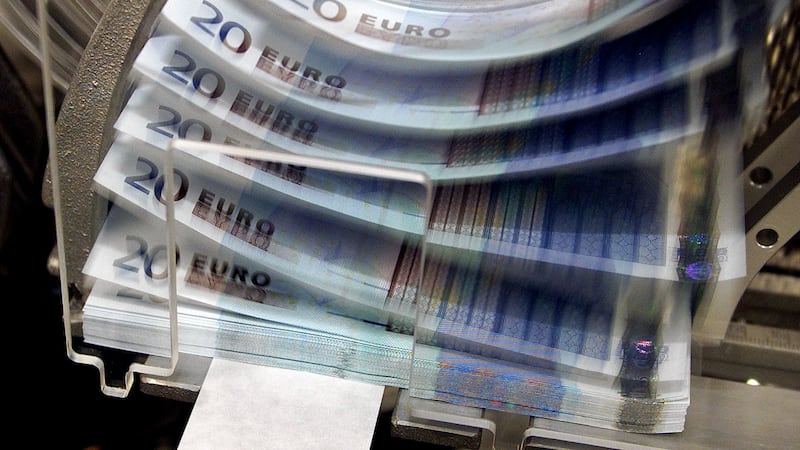It is reporting season for Irish banks, and the big players are making significant profits, with AIB recently reporting profits before exceptional items of more than €1.4 billion and Bank of Ireland announcing underlying profits of €935 million.
Yet because of their ability to continue to write-off losses made during the crash against their profits, these banks are not paying tax on the vast bulk of their profits – nor will they do so for years to come.
Using past losses to claim against future tax is available to all companies, not just banks. On the basis of the scale of losses in Irish businesses after the crash, the Comptroller & Auditor General estimated the cost in future tax revenue from these claims could be as much as €29 billion.

An estimated €12 billion of this relates to the finance and insurance sector in which the Irish banks are a key player.
Given they were bailed out by the taxpayer, is this fair? Or would taxing the banks be shooting ourselves in the foot by cutting the value of the State’s remaining shareholding in the banks?
When it comes to policy towards Ireland’s banks, our role as both shareholders – via the State – taxpayers and customers means defining what is in the public interest is far from straightforward.
********
1. The history
This all goes back to the banking crisis. Under Irish tax laws, companies can write-off losses incurred when calculating future tax liabilities, subject to certain restrictions.
So €100 of losses now can be used to write-off against €100 of future profit.
When the National Asset Management Agency was established in 2009 to take on the bad commercial property loans from the banks, then finance minister, the late Brian Lenihan, decided to restrict the availability of the normal tax relief to the banks involved - of which AIB and Bank of Ireland are now the only survivors.
This legislation said past losses should only be made available to shelter at most 50 per cent of taxable profit in any given year. This was designed to ensure some payback for taxpayers when the banks returned to profit. However, it still meant all the losses incurred during the crash could be written-off in time – just over a longer time frame.
By 2013 the State had bailed out the banks and owned significant shareholdings in them as a result. A note from the Department of Finance on the issue last year to the Oireachtas finance committee said the 50 per cent restriction was "considered to have outlasted its initial purpose to the point where it was deemed to be acting against the State's interests."
So, in Budget 2014, then finance minister Michael Noonan announced the removal of the restriction, meaning the two big banks can continue to offset past losses against all their annual profits.
As well as protecting the value of the State’s shareholding, this was spurred in part by changes in bank capital rules, phased in from 2014. The Department of Finance argued that had the 2009 restriction remained in place, it risked having a negative hit on bank capital under the new rules.
Comptroller & Auditor General estimates there is the equivalent of €29bn in possible future reduced corporation tax receipts for the exchequer
The department said in its note to the Oireachtas committee at the time that the change to allow all profits to be sheltered from past losses “effectively levelled the playing field” as other Irish companies, including other banks which had not gone into Nama, could offset all of their annual profits against past losses.
However, the unique nature of Ireland’s bank bailout, under which taxpayers recapitalised the banks after losses emerged following the transfer of assets to Nama, meant the argument has raged as the banks finally returned to profit in recent years.
2. Where are we now?
The legacy of Ireland’s bust is that huge losses remain available to be offset against tax in the years ahead. According to Revenue Commissioners figures, a total of €214 billion of losses ( including unused capital allowances) was available for offset against profits in 2016, the most recent figure for which data is available.
In 2006, before the bust, just €9 billion was available. So the huge losses within banking and the wider economy sent the figures soaring.
Over 60,000 companies had losses available in 2016 and 26,000 companies from all sectors used these in their tax returns for that year, reducing the tax take by around €1.9 billion.

Over half of the losses carried forward were available to just 26 companies, an average of €4.7 billion each. At the far end of the scale, just over 48,000 companies had losses available totalling €5 billion, an average of just over €100,000 each.
The total losses carried forward, according to an analysis by the Comptroller & Auditor General, translate into the equivalent of €29 billion in possible future reduced corporation tax receipts for the exchequer.
However, a Revenue analysis suggests, under experience to date, many will end up not being used, as – for example – companies are liquidated.
Some €113 billion of the accumulated losses relate to the financial and insurance sector,by far the largest Around half of these were held by AIB, Bank of Ireland and Permanent TSB.
The main argument against change is it would see the value of State's holding in the banks cut
The C&AG report estimated it would take around 12 years, on average, for all the bank losses to be used . However, AIB said previously that on current trends it would not use up all its losses for up to 20 years; looking at current profit trends, Permanent TSB estimated over 20 years, and in 2016 Bank of Ireland said its losses would last for another 13 years or so. Of course all this depends crucially on the level of profits the banks make.
It should be noted the banks do pay some tax as not all their businesses can avail of losses. Recent data suggests the two big banks – Bank of Ireland and AIB – paid around €30 million in corporation tax each on average per annum in recent years.
3. The arguments
On the face of it, the fact that Irish taxpayers bailed out the banks from their huge losses suggests the banks should not necessarily be able to use these losses to avoid paying tax for years to come. But where does the public interest lie here?
The Department of Finance argument is that the banks pay a special levy, equivalent to €150 million across the sector until 2021. For AIB, Bank of Ireland and Permanent TSB, the department calculated the three would have paid €117 million in tax in 2017, versus the levy collected from the three of €101 million.
In making the case for the status quo, the department in its report to the Oireachtas committee makes a few further points.
The main one is that the value of the State shareholding in the banks would be cut if the rules were changed, as investors would factor in higher tax payments in future into the current share price.
If the 50 per cent regime introduced as part of the Nama rules were reinstated, for example, it estimates this could knock around €440 million off the value of State share in the banks. Currently the AIB and Bank of Ireland stakes are worth a combined €8.9 billion.
In terms of AIB, an analysis by Goodbody last year said it attributed 9 per cent of the bank’s value to its deferred tax assets, meaning doing away with them completely could cut the value of the State’s remaining stake – in its current market capitalisation – by upward of €700 million.
The department also argues a change in the rules could weaken the financial position of the banks, make them less competitive and possibly hit their capital position. Bank profitability also benefits the State via dividends from the two biggest banks. Almost €330 million of the €461 million dividend that AIB just declared will go to the exchequer.
What about the counter argument? Sinn Féin, in a position paper on the issue, said the carry forward rules “pay no heed to the fact that these banks (AIB and Bank of Ireland) had loans transferred to Nama and that they were bailed out by the people.”
It wants a limit on the use of losses, so that just 25 per cent could be sheltered in any one year, and a 10-year time limit on the use of the losses incurred during the bust.
The party also points to reform in the UK, where banks paid a levy and where a surcharge linked to profits was introduced in 2016.
Sinn Féin argues the treatment of past losses across the Irish tax system for businesses is generous, in an international context. It says in the case of the banks the estimates to the value of the State holding “is a distraction” when set beside the cash tax foregone would provide.
Sinn Féin’s case for a cap – and a time limit – would mean not all the losses from the crash would be written off against tax, even in the long term. It would mean the banks would pay tax on three-quarters of their profit now and on their full profits after ten years.
4 . The bottom line
The bottom line is the State, after the crash, is left trying to balance its role as shareholder, tax collector and what is in the best interests of the consumer and the economy.
There is no easy solution.
The UK experience is interesting and worth looking at, although there has been criticism of its policy, which will gradually reduce the bank levy as the surcharge kicks in, as being unfair to newer banks and anti-competition.
In Ireland, the fact that the State has a majority stake in AIB and a 14 per cent share in Bank of Ireland and that there are a range of players with foreign ownership makes policy change complicated.
EU state aid rules mean it is difficult to discriminate in any way.
Still, with the current bank levy due to run out in 2021, a decision must be made. It would be perverse to allow the levy to lapse and let the banks make no wider contribution, so it may well be continued.
Perhaps, too, there is a case to consider the wider context at this point and provide a clear indication for the long term to the banks, their shareholders and the market – as well as addressing the issue of fairness for other taxpayers.
For example, is there a case, for setting a phase-out date for the use of the losses incurred during the bust, even if that were to be seven to ten years on?
Or some mechanism to ensure some sharing of benefits of future profits between private shareholders and the exchequer, as the State stakes in the banks are sold?
As we are financially interested shareholders in the banks, there may be a bit of a zero-sum game to whatever is done here.
But ahead of the phase-out of the current levy it is time to try to provide longer-term clarify as banking returns to something approaching normal business.
Smart Money is a a subscriber-only column which looks at the big economic issues and what they mean











